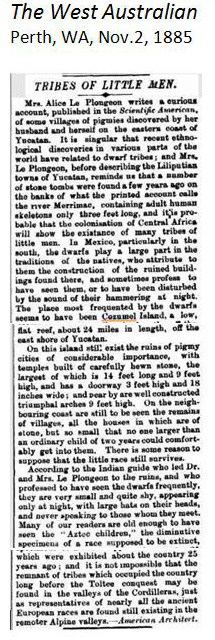
An alux (Mayan: [aˈluʃ], plural: aluxo’ob [aluʃoˀːb]) is the name given to a type of sprite or spirit in the mythological tradition of certain Maya peoples from the Yucatán Peninsula and Guatemala. Aluxes are conceived of as being small, only about knee-high, and in appearance resembling miniature traditionally dressed Maya people. Tradition holds that aluxes are generally invisible but are able to assume physical form for purposes of communicating with and frightening humans as well as to congregate together. They are generally associated with natural features such as forests, caves, stones, and fields but can also be enticed to move somewhere through offerings. Their description and mythological role are somewhat reminiscent of other sprite-like mythical entities in a number of other cultural traditions (such as the Celtic leprechaun, the Scandinavian Gnome, or the European Troll and Gremlin), as the tricks they play are similar.
Some contemporary Maya even consider the single- and double-story shrines that are found scattered around the Yucatan Peninsula to be kahtal alux, the “houses of the alux.” On Cozumel, as well as sites along the Quintana Roo coast, examples of a type of miniature shrine, or oratorio are not uncommon. The most well-known are the group of miniature oratorios at Xcaret and the single shrine of Tumba de Caracol at Punta Sur Eco Park on Cozumel, however there are many more such shrines located in other parts of the island and mainland. These shrines are always located near water, either at the entrance to a wet cave or cenote, beside an aguada, or next to a beach or lagoon. Their diminutive size would have precluded the average sized Mayan from ever actually entering and using the shrine as a normal sized oratorio, and their exact function remains unknown, but they have become associated with aluxes in the minds of the modern Mayan.
Stories say that aluxes will occasionally stop and ask farmers or travelers for an offering. If they refuse, the aluxes will often wreak havoc and spread illness. However, if their conditions are met, it is thought the alux will protect a person or even bring them good luck. If they are treated with respect, they can be very helpful. It is believed that it is not good to name them aloud, as it will summon a disgruntled alux from their home.
The word “duende” is sometimes used interchangeably with “alux.” Duende is a Spanish word for a supernatural creature. In fact, because of such striking similarities, some suspect that the Maya’s belief of aluxes developed through interactions with the Spanish or pirates during the 16th century. Pirates of that era were often from the British Isles, where belief in faeries was quite common. However, the Maya themselves would claim that the aluxes are the spirits of their ancestors, or the spirits of the land itself, preceding contact with Western civilization.
The supposition that aluxes featured in the mythical traditions of the pre-Columbian Maya is possibly supported by similar conceptions postulated from depictions in pre-Columbian artworks, but there is no direct evidence.
Text is available under the Creative Commons Attribution-ShareAlike License
